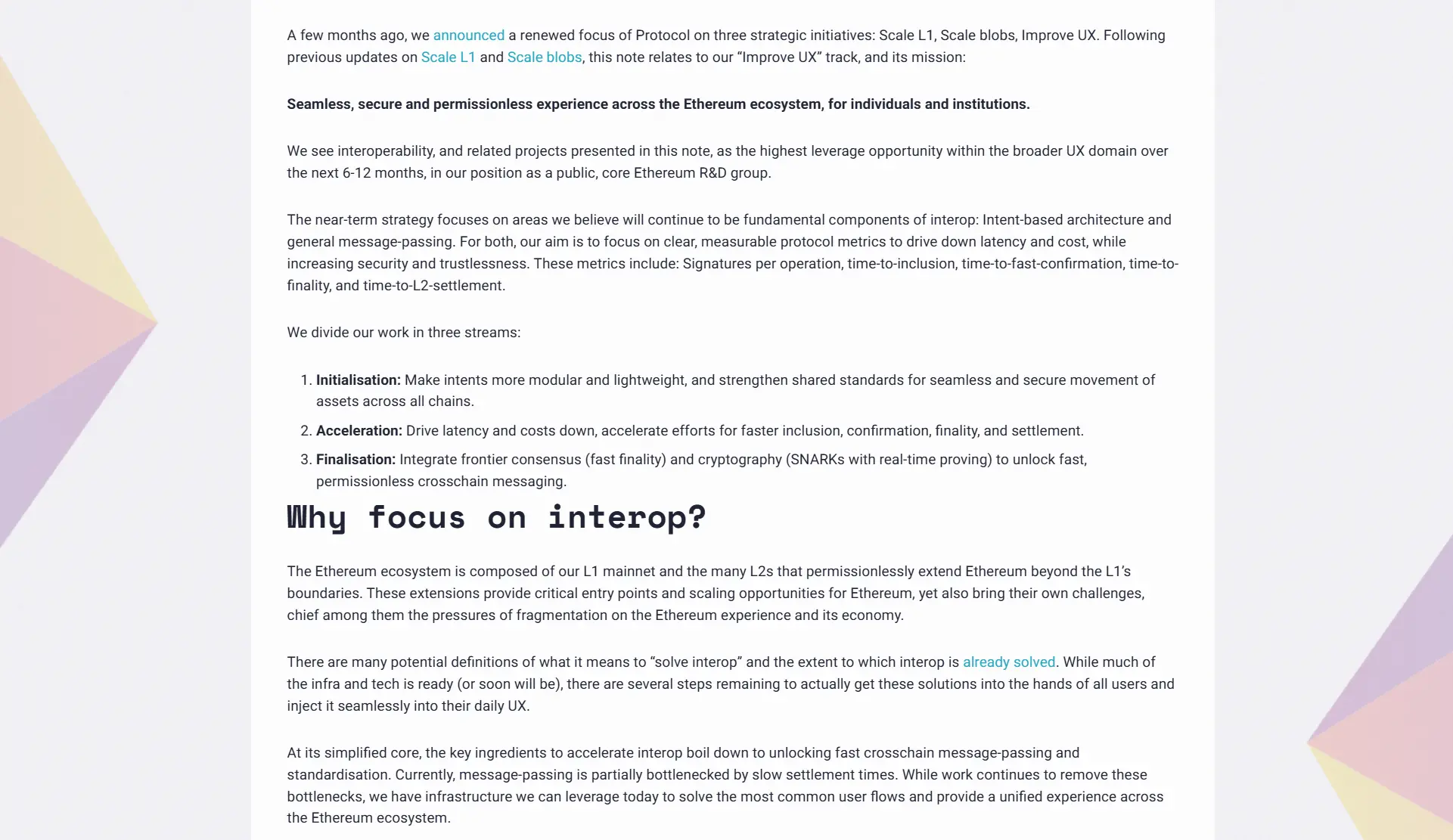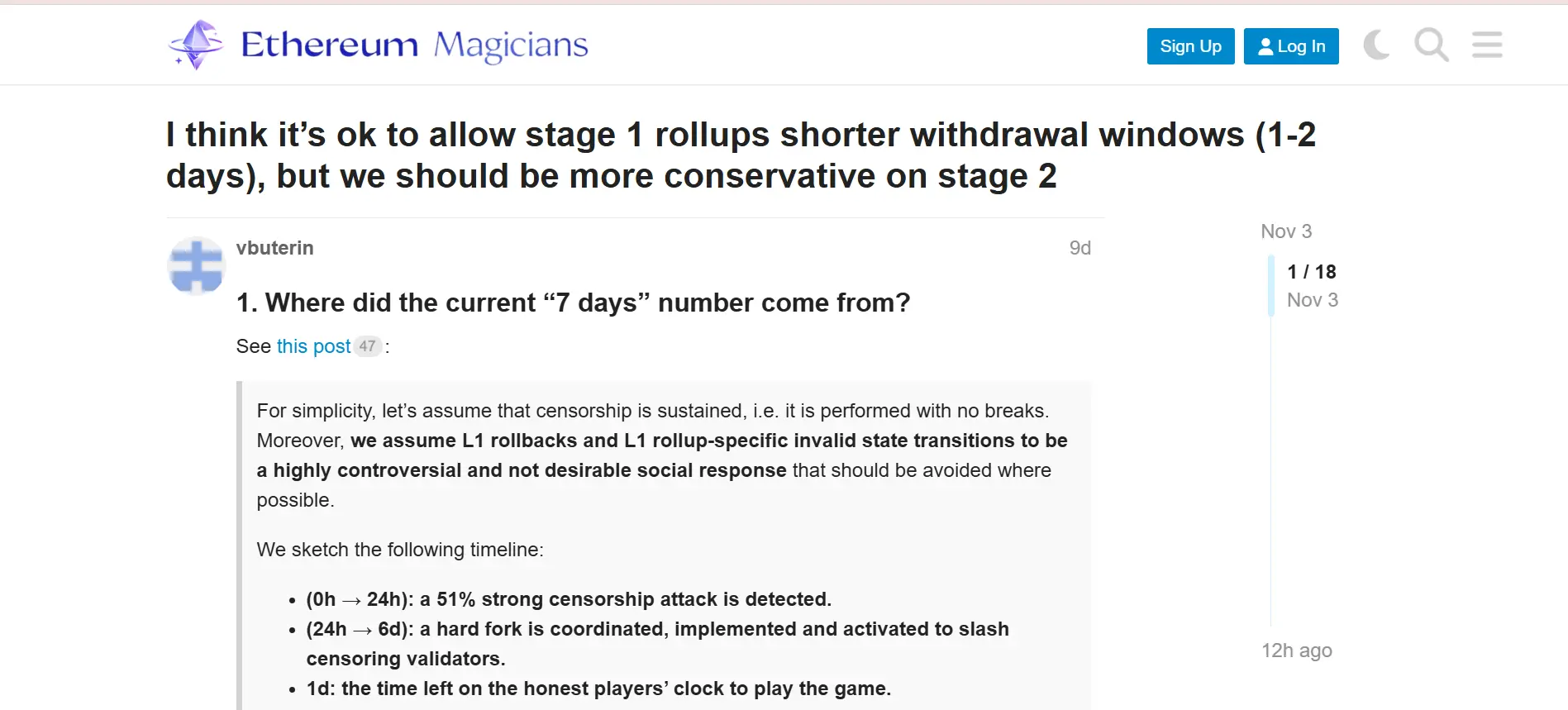Ethereum Interop Roadmap: How to Unlock the “Last Mile” for Mass Adoption
From cross-chain to "interoperability," many of Ethereum's fundamental infrastructures are accelerating towards system integration for large-scale adoption.
Author: imToken
In the Web3 world, the narrative has always revolved around “cross-chain” and interoperability (Interop).
Of course, many people may not strictly distinguish between the two. To summarize in one sentence, cross-chain focuses more on assets, mainly solving the “transfer” problem; while interoperability (Interop) covers multiple dimensions such as assets, states, and services, aiming to solve the “collaboration” problem.
In fact, as the modular narrative has increased the number and heterogeneity of L1/L2s, users and liquidity have become further fragmented. Interoperability is now widely recognized as a more ideal endgame than cross-chain—users no longer perceive which chain they are on, only submitting their intent once, and the system automatically completes the operation in the most suitable execution environment.
With the recent announcement of a new round of UX roadmap by the Ethereum Foundation (EF), and a series of engineering advances around withdrawal latency, message passing, and real-time proofs, the puzzle pieces of interoperability are being methodically put together.
I. What exactly is “Interop”?
Simply put, “interoperability” is far more than just an “asset bridge”; it is a combination of a whole set of system-level capabilities.
It means that different chains can share states and proofs, smart contracts can call each other’s logic, users can enjoy a unified interaction experience, and each execution environment maintains equal trustworthiness in terms of security boundaries.
When these capabilities are met simultaneously, users can truly focus on value activities themselves, no longer troubled by network switching, repeated authorizations, or fragmented liquidity. This also echoes the endgame of cross-chain engineering: enabling users to focus on the flow of value itself, rather than the barriers between chains (see also “The Evolution of Cross-Chain Engineering: From ‘Aggregate Bridges’ to ‘Atomic Interoperability’, What Kind of Future Are We Heading Towards?”).
Especially since entering 2024, the modular narrative has entered a full-blown phase, with more and more fragmented L1s and L2s emerging, making interoperability no longer just a high-level protocol discussion, but truly sinking into the user experience and underlying application logic.
Whether it’s intent-centric execution architectures, cross-chain aggregation, or new forms of applications like omnichain DEXs, all are exploring the same goal: enabling users and liquidity to no longer be limited to the Ethereum mainnet, without frequent network switching, and allowing on-chain asset swaps, liquidity provision, and strategy operations to be completed in a unified interface, all in one place.
In other words, the ultimate vision of interoperability is to completely abstract the blockchain away from the user’s view—allowing DApps and project teams to return to a user-centered product paradigm, creating an easy-to-use, Web2-like low-barrier environment, and removing the final obstacle for mainstream users to seamlessly enter the Web3 world.
After all, from a product perspective, the key to mainstream adoption is not making everyone understand blockchain, but enabling them to use it without understanding. It can be said that if Web3 is to reach billions of people, interoperability is the “last mile” of infrastructure.
As early as August 29, the Ethereum Foundation released “Protocol Update 003 — Improve UX”, an article that continued EF’s three strategic directions after this year’s R&D team reorganization—Scale L1 (mainnet scaling), Scale Blobs (data expansion), and Improve UX (user experience improvement).
Among them, the core theme of “Improve UX” is interoperability.

Source: Ethereum Foundation
II. From “Cross-Chain” to “Interoperability”: Signals from EF
This article from EF emphasizes interoperability (interop) as the core, aiming for a seamless, secure, and permissionless Ethereum ecosystem experience. The main point can be summarized in one sentence: cross-chain asset transfer is only the first step; cross-chain collaboration of data, states, and services is true “interoperability”. In the future, Ethereum plans to make all Rollups and L2s “look like a single chain”.
Of course, EF also admits that although most of the infrastructure and technology are already mature (or about to mature), delivering these solutions to users and integrating them naturally into wallets and DApps’ daily experience still requires several key engineering implementation steps.
Therefore, EF has split the R&D work of “Improve UX / Interop” into three parallel tracks: Initialization, Acceleration, and Finalization.
First is the “Initialization” step, aiming to be the starting point of interoperability, making Ethereum’s cross-chain behavior lighter and more standardized.
The core work includes making intents lighter and more modular, establishing general standards, opening up the path for cross-chain assets and operations, and providing interchangeable and composable general interfaces for different execution layers.
Specific projects include:
- Open Intents Framework (OIF): a modular intent stack co-developed by EF, Across, Arbitrum, Hyperlane, LI.FI, OpenZeppelin, etc., supporting free combination of different trust models and security assumptions;
- Ethereum Interoperability Layer (EIL): led by the ERC-4337 team, building a permissionless, censorship-resistant cross-L2 transaction transport layer, making multi-chain transactions as natural as single-chain ones;
- A set of new standards (ERC series): covering interoperable addresses (ERC-7828/7930), asset integration (ERC-7811), multicall (ERC-5792), intents and general message interfaces (ERC-7683/7786);
The goal is straightforward: to decouple “what the user wants to do” (declarative) from “how the system executes” (procedural), and enable wallets, bridges, and verification backends to collaborate under unified semantics.
Next is the “Acceleration” phase, reducing latency and costs to make multi-chain more real-time.
This focuses on reducing time and cost for measurable indicators such as “number of signatures, inclusion time, fast confirmation, finality, L2 settlement”. Measures include L1 fast confirmation rules (bringing strong confirmation forward to the 15–30 second range), shortening L1 slot time (research and engineering to reduce from 12s to 6s), and shortening L2 settlement/withdrawal windows (reducing optimistic 7 days to 1–2 days, or introducing ZK proofs and 2-of-3 fast settlement mechanisms). These initiatives essentially lay the foundation for cross-domain message passing and unified experience.
The final step is “Finalization”, combining real-time SNARK proofs with faster L1 finality to explore second-level endgame interoperability forms. In the long run, this will redraw the landscape of cross-domain issuance, bridging primitives, and cross-chain programmability.
Objectively speaking, in the Ethereum context, Interop (interoperability) is no longer limited to the concept of “asset bridges”, but is a collective term for a whole set of system-level capabilities:
- Cross-chain data communication — different L2s can share states or verification results;
- Cross-chain logic execution — a contract can call the logic of another L2;
- Cross-chain user experience — users see only one wallet and one transaction, not multiple chains;
- Cross-chain security and consensus — maintaining equal security boundaries between different L2s through proof systems;
From this perspective, Interop can be understood as the universal language between future Ethereum ecosystem protocols. Its significance lies not only in value transfer, but also in shared logic.
III. How is Ethereum paving the way for “Interoperability”?
It is worth noting that recently Vitalik also initiated a discussion on the Ethereum Magicians forum about shortening the Stage-1 (first stage) optimistic rollup withdrawal time, advocating to reduce the withdrawal period from the traditional 7 days to 1–2 days, and proposing to gradually introduce faster settlement and confirmation mechanisms under controllable security conditions.
On the surface, this discussion is related to the withdrawal experience of Rollups, but in essence, it directly responds to one of the three directions of “interoperability”—Acceleration.

Source: Ethereum Magicians
After all, withdrawal latency is not just a user experience issue of waiting too long, but a liquidity bottleneck for the entire multi-chain collaboration system:
- For users, it determines the speed at which funds move between different Rollups;
- For intent protocols and bridge networks, it affects the capital efficiency of solutions;
- For the Ethereum mainnet, it determines whether the ecosystem can maintain consistency and security in higher-frequency interactions;
Vitalik’s viewpoint essentially opens the floodgates for this. In short, shortening withdrawal time not only improves the user experience of Rollups, but is also an infrastructure upgrade that unlocks fast cross-domain messaging, liquidity, and state transfer. This direction is fully aligned with EF’s goal in the “Acceleration” track: shortening confirmation times, increasing settlement speed, reducing in-transit capital costs, and ultimately making cross-chain communication real-time, trustworthy, and composable.
This series of efforts will echo the Devconnect event to be held in Argentina on November 17 (UTC+8). According to the official agenda, Interop will be one of the key themes of this year’s Devconnect, and the EF team will announce more details related to EIL (Ethereum Interoperability Layer) at the event.
Overall, all of this points in the same direction—Ethereum is completing the transition from “scaling” to “integration”.
Of course, as the first article in the Interop series, this piece only raises the fundamental question that interoperability is the endgame of the cross-chain narrative, and offers a preliminary glimpse at the current technical roadmap from EF to Vitalik’s real-time discussions, from standardized engineering layouts to gradually shortened settlement cycles. We are witnessing yet another structural upgrade of the Ethereum ecosystem.
We will continue to explore from different perspectives why interoperability is not just a bridge, but the underlying protocol connecting Ethereum’s future.
Stay tuned.
Recommended reading:
Rewriting the 2018 script, will the end of the US government shutdown = a bitcoin price surge?
1.1 billions USD stablecoins evaporated, what’s the truth behind the DeFi domino crash?
MMT short squeeze review: a carefully designed money-grabbing game
Disclaimer: The content of this article solely reflects the author's opinion and does not represent the platform in any capacity. This article is not intended to serve as a reference for making investment decisions.
You may also like
Uniswap Labs Faces Pushback as Aave Founder Highlights DAO Centralization Concerns

A $170 million buyback and AI features still fail to hide the decline; Pump.fun is trapped in the Meme cycle
Facing a complex market environment and internal challenges, can this Meme flagship really make a comeback?

Saylor Dismisses Sell-Off Rumors as Strategy Increases Bitcoin Holdings Amid Market Drop

